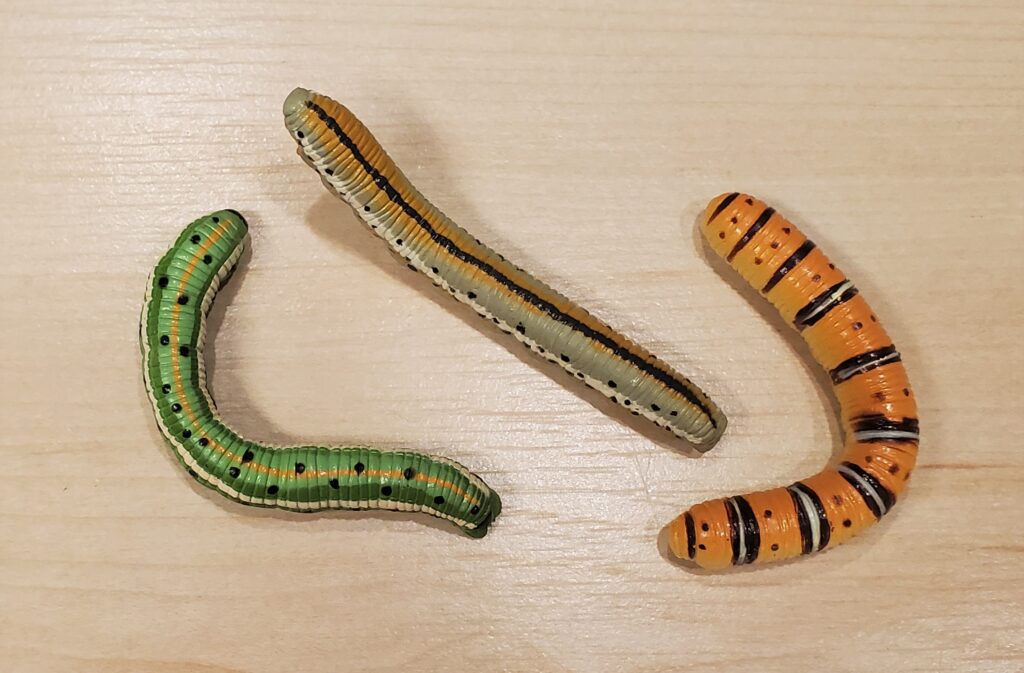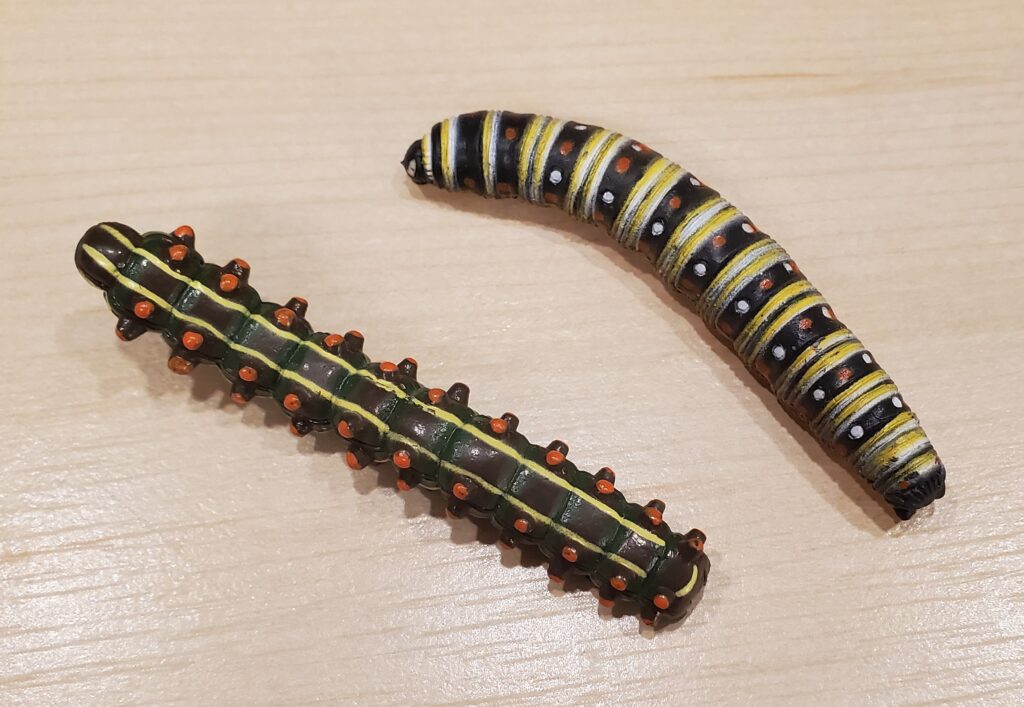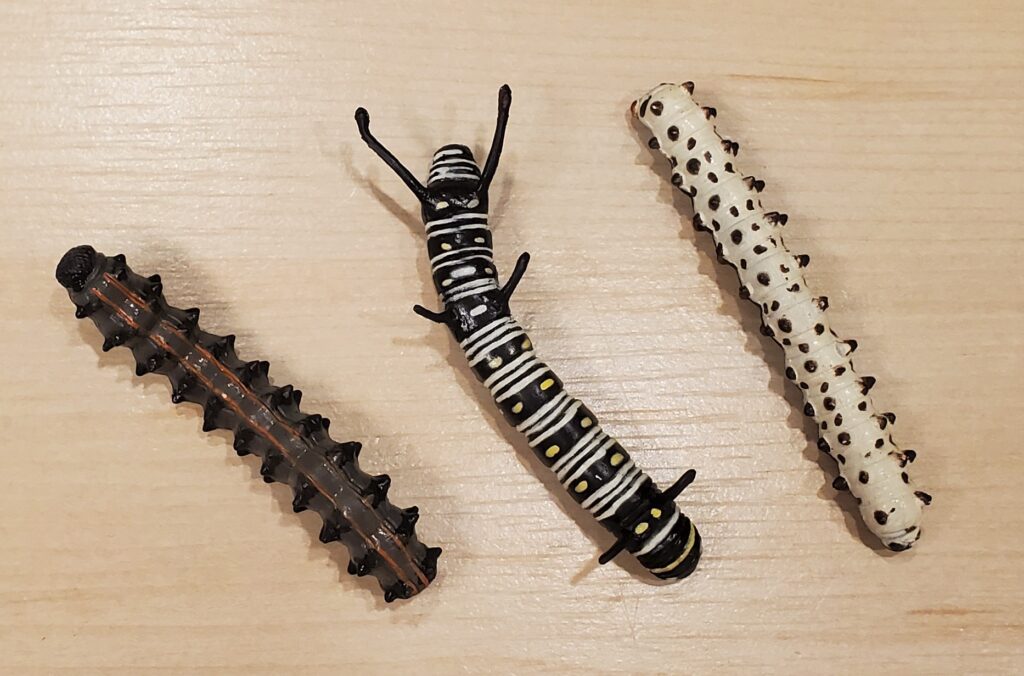Nearly two years ago to the day, I reviewed Club Earth’s Butterflies to Go collection after acquiring the last figures for that Holy Grail collection. Now today I get to do the same thing for the Caterpillars to Go collection, again having received the last figure in this Holy Grail Collection. As with the Butterflies collection, I am not aware of when the set was first released, but I suspect the mid-late 1990s. There are 12 species in the set, each marked with the Latin name on the underside. All species appear to be endemic to North America, or at least represented North American taxa when the set was released. However, with taxonomic changes and updates, two of the species are now restricted to Central and South America and the Old World, respectively. I am maintaining the identification based on the Latin name, rather that attempting to make assumptions of what the manufacturer intended. The figures are not to scale and approximately 7-9 cm in body length. These figures have been copied and bootlegged MANY times over the years, so you may recognize many of them by shape if not color. There have been some nicer sets which were obviously influenced by this collection, but are not exact copies, as the caterpillars are in different shapes and positions. The best example of such a set is the Imomushi collection by Beam.

As with the Butterflies collection, I am combining multiple taxonomically-related species into one image, due to the simple design of the figures. I am also including their geographic distribution, host plants, and a comment or two about their frequency in toy form (exclusive of outright bootlegs).
First up, the sulfurs and orange-tips (family Pieridae); from left to right:
- falcate orange-tip, Anthocharis midea. This orange-tip occurs throughout much of the eastern United States. Host plants are members of the mustard family, including Arabis, Arabidopsis, Barbarea, Boechera, Cardamine, and Lepidum. The only other figure of this species I am aware of is by Beam (Imomushi).
- creamy marblewing, Euchloe ausonides. This pierid occurs in western North America. Host plants are members of the mustard family, including Arabis, Isatis, Sisymbrium, and Brassica. The only other figure of this species I am aware of is by Beam (Imomushi).
- cloudless sulfur, Phoebis sennae. This large yellow occurs from South America north to southern United States, with late summer and fall migrations north to southern Canada. Host plants are members of the genera Senna and Cassia. To my knowledge, this figure is unique for this species.

Next up, the swallowtails and parnassians (family Papilionidae); from left to right:
- pipevine swallowtail, Battus philenor. This swallowtail occurs in eastern North America, south and west to California and Mexico (it was a common swallowtail where I grew up in Arizona). Host plants are pipevines in the genus Aristolochia. Beam also produced a caterpillar of this species, and Toy Major an adult.
- anise swallowtail, Papilio zelicaon. This swallowtail occurs in western North America, from British Columbia to Baja California, east to the Dakotas. The anise swallowtail has a broad host plant range, including many plants in the parsley family (Apiaceae) and some citrus (Rutaceae). Beam also produced a caterpillar of this species, and Toy Major an adult (although that latter ID is a tenuous one of mine).
- small Apollo, Parnassius phoebus. This ‘tailless swallowtail’ occurs in montane regions of the Palearctic, including the Alps, the Urals, and mountainous regions of Siberia, Kazakhstan, Mongolia, and China. Interestingly, the North American species P. smintheus has historically been incorrectly referred to as P. phoebus. Given the prevalance of North American species in this set, it’s possible this figure was intended to represent what is now known as P. smintheus. The paint job does seem to favor P. phoebus, however, as P. smintheus tends to have additional rows of yellow spots running down the body. I am sticking with the identification based on the Latin name printed on the bottom. Host plants include Saxifraga, Sedum, and Sempervivum. The only other figure of this species I am aware of is another caterpillar by Beam.
- zebra swallowtail, Protographium marcellus. This swallowtail occurs throughout much of eastern North America. Larvae feed on plants in the genus Asimina (commonly called pawpaw). The only other figure of this species I am aware of is another caterpillar by Beam.

Next, members of the subfamily Nymphalinae in the family Nymphalidae; from left to right:
- Mylitta crescent, Phyciodes mylitta. This small checkerspot butterfly occurs in western North America. Larvae feed on Cirsium and Carduus. The only other figure of this species I am aware of is another caterpillar by Beam.
- American painted lady, Vanessa virginiensis. This common and familiar butterfly occurs throughout much of North America, south to Columbia and Venezuela. It also occurs on Madeira and the Canary Islands, and vagrants are often found on continental Europe. It has been naturalized in Hawaii. Larvae feed on several plants in the family Asteraceae. The only other figure of this species I am aware of is another caterpillar by Beam.

Lastly, members of the subfamilies Heliconiinae (longwings) and Danainae (milkweed butterflies) in the family Nymphalidae; from left to right:
- Gulf fritillary, Agraulis vanillae. In 2022, A. vanillae was divided into eight species based on molecular data. True A. vanillae is found in northern South America, Panama, and southern Lesser Antillies. The species found in the United States, which is the species this figure was probably based on, is now known as A. incarnata. However, I am keeping with Latin name on the underside, rather than the presumptive intention of the manufacturer. Host plants are passionflowers in the genus Passiflora. This figure is unique for this species, to the best of my knowledge.
- queen, Danaus gilippus. This cousin of the monarch occurs in the southern United States south to South America. Larvae feed on Asclepias and other members of the milkweed family. Beam also made a caterpillar of this species and Toy Major an adult, although the latter is a tentative identification of mine.
- zebra longwing, Heliconius charithonia. This attractive longwing occurs in extreme southern United States (southern Texas, Florida), Central and South America, and the West Indies. Larvae feed on passionflowers of the genus Passiflora. The only other figure of this species I am aware of is an adult by Innovative Kids for the Junior Groovies book series.

As with the Club Earth Butterflies to Go set (and most any Club Earth set), this is a great way to add a lot of interesting and unique or otherwise rarely made taxa to one’s collection! However, like most CE collections, they are long since retired and may be difficult to find. They are almost never on eBay and I acquired most of mine via trades or purchases from other collectors on the forums.
Disclaimer: links to Ebay and Amazon on the AnimalToyBlog are affiliate links, so we make a small commission if you use them. Thanks for supporting us!



